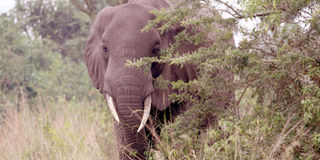Poor planning pushing more people into path of enraged animals

Experts are blaming the rising cases of human-wildlife conflict on poor land use and planning. Photo/FILE
What you need to know:
- Close to 200 people have been killed and thousands others injured over the last couple of years as families build homes on wildlife migratory routes
Experts are blaming the rising cases of human-wildlife conflict on poor land use and planning.
Last year 52 people were killed, 425 others injured and crops worth millions of shillings destroyed by wildlife, mostly elephants.
The Kenya Wildlife Service (KWS) spent Sh66 million on compensation for deaths and injuries.
“People have encroached on arid and semi-arid areas and introduced farming in wildlife territory. When the animals venture into their territory, humans complain that their crops are being destroyed,” said Mr James Isiche, the regional director of the International Fund for Animal Welfare (Ifaw).
He said that with proper planning, people in arid and semi-arid lands would be discouraged from farming and supported to stick to livestock rearing.
KWS head of species Patrick Omondi said cases of human-wildlife conflict have risen sharply since the 1980s when poachers almost decimated the elephant stock.
In 1973, there were 167,000 elephants in Kenya but poachers reduced them to 16,000 by 1989.
Mr Omondi said when the elephant population fell, humans invaded their ecosystem.
“The dwindling area in which elephants forage is fuelling the human-wildlife conflict. Human settlement, agriculture and climate change have interfered with corridors like Mt Kenya, the Aberdares, Sangari and Maasai Mara where settlers from other communities have influenced the pastoralist Maasai to engage in farming which interferes with wildlife.
In areas like Kitengela, human settlement has interfered with the corridor,” he said.
The elephant population has risen to 35,000, thanks to measures such as public education and fencing national parks and game reserves.
Mr Michael Kipkeu, who is in charge of community services at KWS, said 1,093 cases of human-wildlife conflict were reported in 2010, of which 877 were injuries. He said most of the deaths and injuries were caused by elephants, crocodiles and lions.
This year, Mr Kipkeu said 279 cases had already been recorded of which 42 are deaths.
“We are waiting for Sh21 million from the Treasury to compensate the families,” he said.
In 2010, Mr Kipkeu said KWS recorded 975 cases — 152 deaths and 823 injuries. Families of the victims were paid Sh71 million in compensation.
Compensation fees have risen over the years from Sh15,000 to Sh50,000 for injury and from Sh30,000 to Sh200,000 for death. People living nears parks want the amount increased five fold.
The Wildlife Compensation Bill proposes a compensation of Sh1 million for every death.
Mr Kipkeu said migration corridors for animals like elephant had been interfered with, leading them to stray into villages.
He said the five water towers of the country needed to be protected so that wild animals do not lack water even during the dry seasons.




